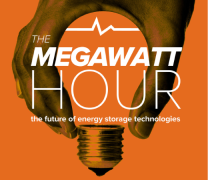
The Megawatt Hour is the latest podcast boxset brought to you by Energy Voice Out Loud in paid partnership with BDO. This new monthly series will examine how energy storage technologies are reshaping, reinforcing and recharging energy markets in the UK and around the globe.
In this first episode, content editor Andrew Dykes is joined by co-host David Bevan, corporate finance partner at BDO and by special guest Marek Kubik, a founding member and managing director of energy storage technology company Fluence (NASDAQ: FLNC), who are co-owed by AES (NASDAQ:AES) and Siemens (ETR:SIE).
Together they take a broad look at some of the fundamentals of energy storage including the range of technologies available, how they work, and why the market is really taking off today as increasing amounts of new renewable capacity is added to the grid.

What is energy storage?
As Mr Bevan explains, it’s helpful to think of energy storage “essentially as a form of flexibility,” enabling grid operators to balance the competing needs of supply and demand. This could be over very short periods – stabilising milliseconds of imbalances on the grid – or retaining energy for hours, days and months.
In a nutshell though, it is about “taking power that’s been generated at one point in time, keeping hold of it and using it again at a different time when you need” – a process likened by Mr Kubik to an “electron time machine”.
Energy storage technologies
There are various technologies for energy storage, ranging from the more established such as pumped hydropower – which as Mr Kubik points out, still accounts for more than 85% of all global energy storage capacity – to the ultra-modern such as large-scale lithium-ion batteries or liquefied compressed air (CAES).
Fossil fuels too provide a form of energy storage. Gas, coal and oil for example, can all be produced and stockpiled before being burnt to produce power and heat when needed.
“There are also various ways of characterising them or assessing them,” Mr Bevan notes, ranging from their power output and capacity (typically in Megawatts and Megawatt-hours, respectively), to cost, and their scalability.
Various technologies can also respond to supply and demand with differing speed – batteries being perhaps the fastest and most nimble, but which usually operate for shorter lengths of time.
Renewable energy storage
What is now spurring development of the sector in addition technological advances, as Mr Kubik notes, is the rapid deployment of new renewables capacity.
“You essentially need some way of dealing with the intermittency of renewables – whether that’s because the sun simply doesn’t shine at night, or whether it’s dealing with smoothing the balance of supply and demand.”
Yet while there are plenty of options for storing energy for hours, or days, there are fewer clean alternatives for monthly and seasonal shifting. A recent report on Europe’s energy sector found that daily storage capacity would support a 60% renewable energy mix, but to reach 80% and beyond, other solutions will be required.
Long-duration energy storage
“It’s quite evident that we haven’t needed long duration storage because we’ve had a very effective and relatively low carbon compared to some of the other fossil fuel technologies on the electricity grid,” he explained.
“The most challenging and the most interesting I think is the seasonal storage and finding a low carbon way of doing that, and there are a lot of potential technologies that can help achieve that – Power-to-X being one.”
He said this could involve running electrolysers to take electricity and turn it into hydrogen, or thermal storage such as heating up rocks which maintain a very stable temperature, which can then be extracted later on.
“There are multitude of different ways that the long duration challenge can be solved, but they’re also sort of the furthest out in terms of their maturity – and you will need all three, if you want to get a fully decarbonised electricity system, which we do by 2050.”
Qualifying and building out more of these types of solutions will be one of the major challenges for the sector in the coming decades.
UK Regulatory changes to energy storage capacity
Both experts agreed that the storage sector has progressed rapidly in the last four of five years, with Mr Kubik pointing to a growing momentum as companies like Fluence gain more experience.
Some regulatory barriers have been removed – in particular, capacity constraints in the UK, and an awareness of energy storage as a standalone service within the market.
He added: “The very early projects that Fluence were doing in other electricity markets – we had to make batteries look as much like a coal power plant as possible because otherwise they wouldn’t actually be allowed to connect to the grid.”
That has seen “an increasing number of players, institutional investors, putting money directly into utility scale, battery storage, and the projects are getting bigger and more sophisticated,” concurred Mr Bevan.
Despite this progress however, some challenges remain.
Energy Storage risks
He pointed to the ongoing risk of volatile energy prices, meaning “it’s still probably quite difficult to predict pricing in these markets going forward.”
“We’ve seen how difficult it is to predict power prices in the pure generation markets, but I suspect there will be more volatility in the storage market, so the risks haven’t completely disappeared.”
That extends to the supply chain too, where competition is increasing as batteries are sought after for vehicles as much as stationary storage applications, noted Mr Kubik.
Nevertheless, both remain confident these are short term issues in a market that can only grow over the medium and longer term, particularly as new providers garner the attention of major institutional investors.
“It’s hard to argue we’re not going in the right direction giving the explosion in developments that we’re seeing. We’re even seeing now most renewable generation development projects usually have some kind of parallel planning application for a storage site,” added Mr Bevan.
“The market clearly sees the need for storage and is factoring that into the very early stages of planning and development for renewables generally.”
Growing energy storage industry
Further afield, Mr Kubik pointed to a host of applications around the globe that can only add to the appeal of a thriving flexible energy storage sector.
This includes using batteries to help bolster energy security in Eastern European states keen to decouple from the Russian energy grid; markets like Israel, where large volumes of storage help maximise the nation’s significant solar resources; and the US, where batteries are increasingly taking the place of gas peaker plants as environmental and sustainability concerns rise on state agendas.
And with policy, demand and regulation now in greater alignment, that pipeline of projects is only set to grow as the energy transition continues.
Listen to the Megawatt Hour podcast by Energy Voice Out Loud here.
Recommended for you









